Highlights:
- Are your ecommerce sales down? Optimizing your website can boost conversions significantly
- Learn why a CRO strategy is essential for ecommerce businesses
- Follow simple tips to improve your product pages, checkout process, and more
- Do online shoppers mostly use desktop or mobile devices? Let’s find out
- Pair your CRO strategy with personalized landing pages to achieve ideal conversion rates
The digital marketplace is highly competitive, simply having an online presence doesn’t cut it anymore.
This statement is truer than ever before.
Ecommerce businesses that want higher sales and lower cart abandonment rates need to employ conversion rate optimization best practices on their websites.
Let’s dive into how ecommerce businesses should use ecommerce CRO to effectively improve their websites for visitors and leads.
What is Ecommerce CRO?
Ecommerce conversion rate optimization (CRO) is the process of making strategic changes and improvements to an ecommerce site with the goal of increasing the percentage of visitors who take a desired action, such as adding an item to their cart or making a purchase.
By improving your ecommerce website with CRO strategies, you can provide a better user experience, increase your conversion rate, and boost revenue.
Conversion rate optimization strategies focus on several key metrics, with an emphasis on increasing sales conversion rates and add-to-cart rates, and lowering cart abandonment rates.
Ways to increase ecommerce conversion rates
Optimize product pages
Product pages play a pivotal role in whether or not visitors take conversion actions. The purpose of these pages is to convince potential customers to make a purchase.
Take the following steps to audit your product pages and optimize them for conversions:
- Include high-quality images and videos. Online shoppers want to know what they’re buying. To build purchase decision confidence, share high-resolution images from different angles and videos that show the product in use.
- Optimize product descriptions. A well-written, easy-to-understand, and clearly communicated product description is crucial. Make sure user benefits and product features are represented clearly.
- Include customer reviews. Social proof lends plenty of credibility and signals to potential customers that this is a trustworthy product. Make sure to include a mix of reviews on your product pages that showcase your product in an authentic and believable way.
The product page for the Peak Design Everyday Backpack has it all: multiple photos that clearly show the features of the backpack, what it looks like from every angle, and what colors you can choose from. Trust badges from notable publications and well-placed CTA buttons to make navigation simple.
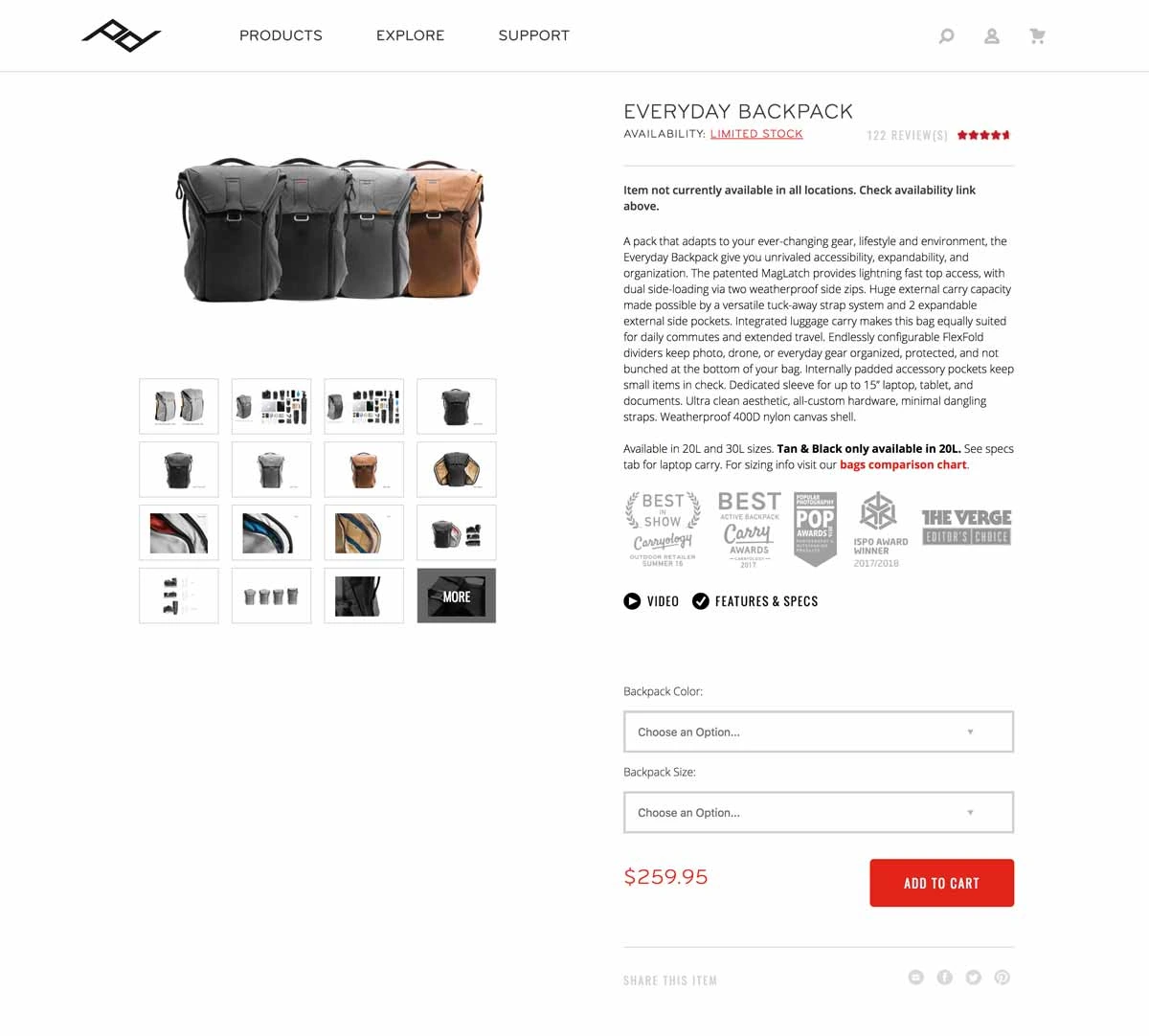
Streamline your checkout process
When cart abandonment is high, the first place you should look at is your checkout process. If the process is too complicated or frustrating, visitors won’t hesitate to abandon the page and move on.
Simplify your ecommerce checkout process with these simple tips:
- Offer guest checkout. Forcing users to create an account before they can complete a purchase makes for a bad user experience. Offer a guest checkout option that allows customers to buy your product without friction or unnecessary commitment.
- Add trust signals for credibility. People want to feel like they’re making a secure purchase, and visual cues like secure payment icons or SSL certificates can signal to your visitors that their information is safe.
- Optimize form fields. Keep your checkout form as short and simple as possible. Only ask for information that’s necessary, which will minimize distractions and reduce the risk of a customer abandoning that form.
The Allbirds checkout page is strictly about your purchase – there’s no menu or navigation links to distract you and tempt you to abandon the page, you’re able to checkout as a guest, and the only information you have to input is your shipping and payment information.
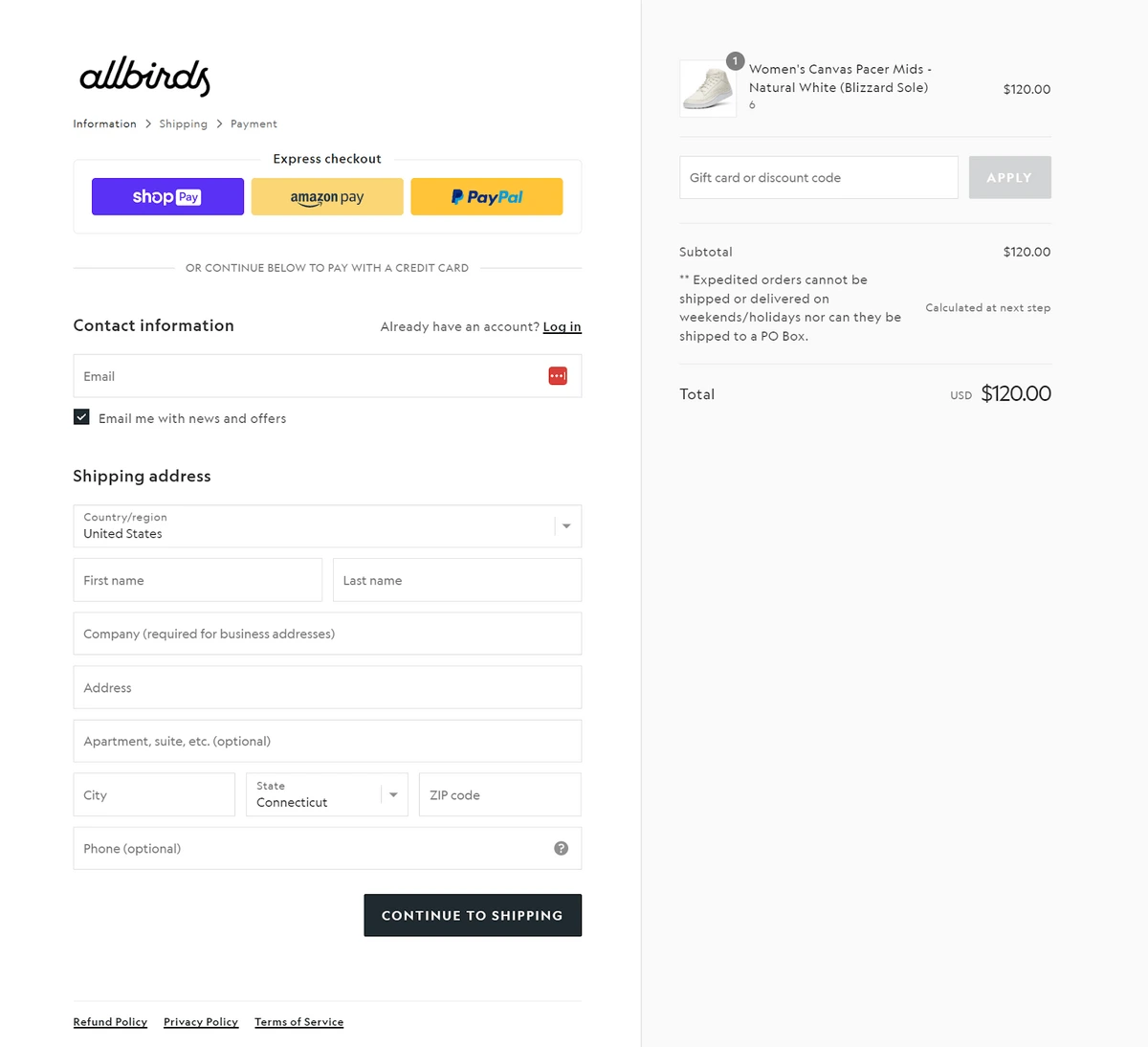
Use social proof
We are natural vetters – before we try out a restaurant, we’re likely to ask others for recommendations or read reviews on sites like Yelp. We regard the opinions of others when making decisions, so leveraging social proof is one of the most effective conversion rate optimization strategies to improve ecommerce sales.
Here’s how:
- Utilize customer reviews and testimonials. Positive customer reviews and testimonials are not just a nice-to-have, they are powerful tools. They build trust and can nudge buyers towards that purchasing decision.
- Encourage customer feedback and reviews via post-purchase emails. After a customer has made a purchase, you can send a follow-up email to encourage them to leave a review and help future customers make a decision.
- Feature positive customer experiences as case studies. Case studies can also be powerful in the decision-making process. Reading about a successful experience can give potential customers ideas about how to use the product and what their own experience might be like.
Fresh dog food company The Farmer’s Dog knows reviews are essential for potential customers and puts an emphasis on them. As the first option in their navigation menu, their reviews page includes testimonials left on Google, videos, testimonials left by veterinarians, and more customer reviews.
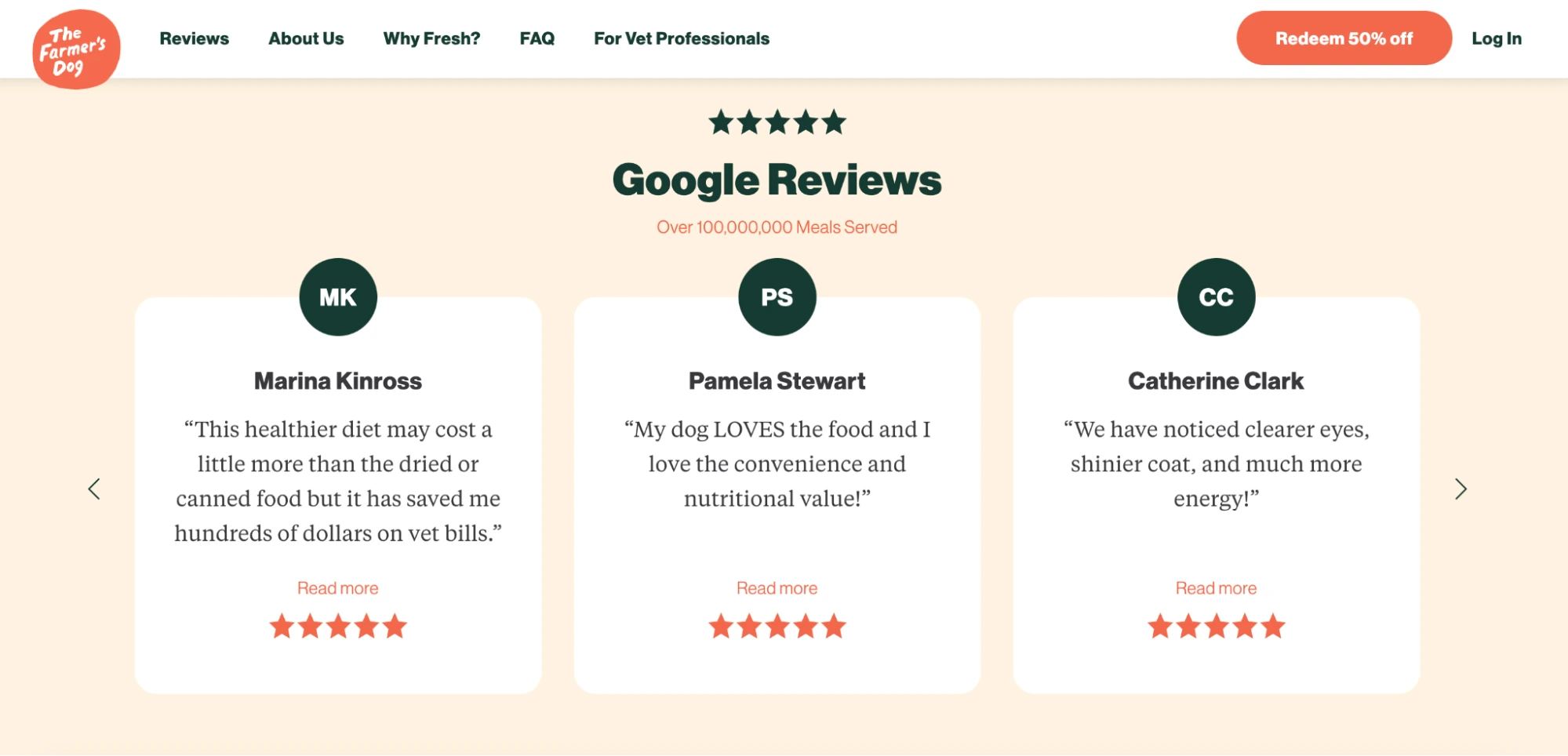
Personalize user experience
Today’s consumers want and expect personalized experiences. To provide a tailored user experience follow these tips:
- Use A/B testing. Run experiments to understand how variations on your website affect conversion rates. This could be as simple as changing the color of your CTA button or using a different copy in your headline. Customer data, feedback, and A/B tests can help you choose the best conversion rate optimization strategies.
- Implement strategies based on user behavior. We live in an age where customer data is readily available and can be used to personalize recommendations, on-page content, and marketing efforts. When you personalize based on browsing history, preferences, and demographics, customers feel understood and valued and are more likely to make a purchase.
Dick’s Sporting Goods uses its website visitor’s locations to show them popular items in their area. This kind of personalization shows visitors items that are tailored to their specific interests and encourages them to make a purchase that will benefit them.
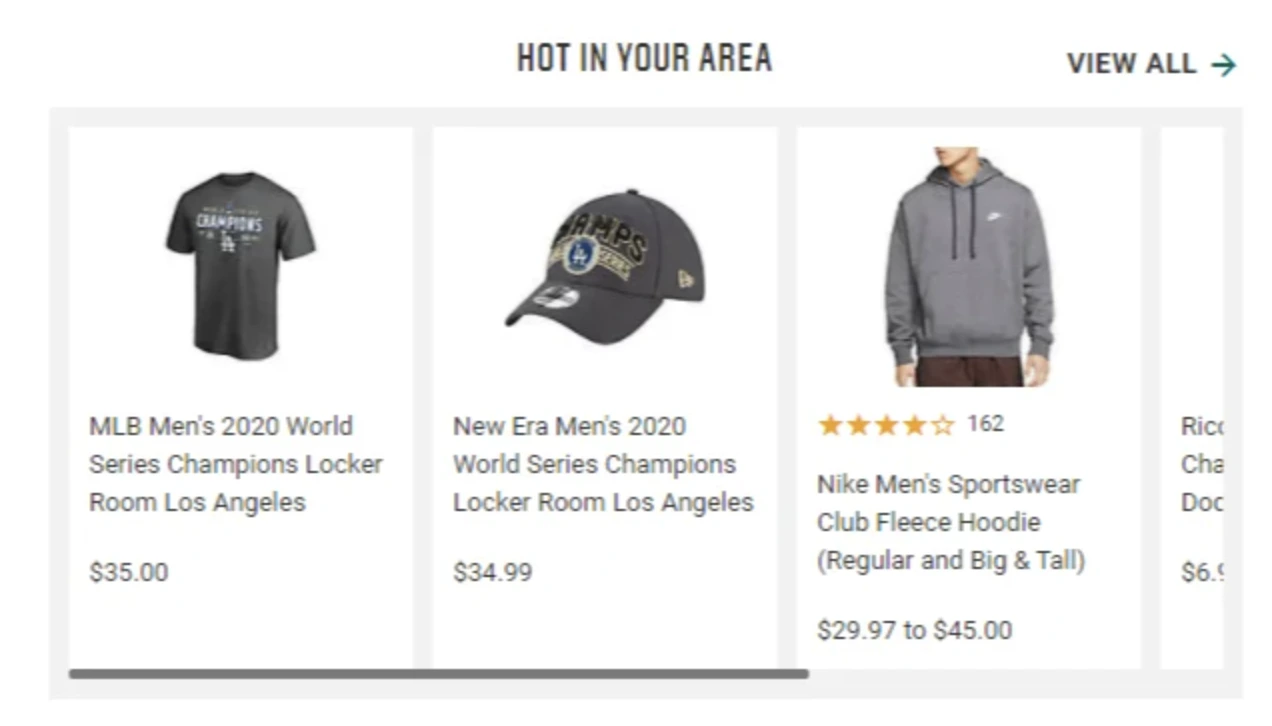
Improve site speed and mobile responsiveness
Internet browsing is a much quicker experience than it used to be, and customers expect pages to load instantly and be responsive, especially on mobile devices. If your page speed load and mobile responsiveness are not up to par, your performance will suffer. Here’s how to ensure your site is ready to go:
- Ensure mobile responsiveness. You can’t rely just on desktop experiences. More and more customers are shopping from mobile devices, and it’s essential that your ecommerce site functions seamlessly on any screen. Use a responsive design that adapts to any display size, whether on a mobile, tablet, or desktop.
- Optimize website loading speed. If your page takes too long to load, customers will abandon it. A tool like Google PageSpeed Insights can help you evaluate your website’s speed and direct you to compress images, enable caching, or reduce HTTP requests to improve speed.
Analyze user behavior and identify pain points
A crucial aspect of ecommerce conversion rate optimization is understanding user behavior. By analyzing how visitors interact with your website, you’ll have data-driven insights that can help you identify what’s working and what needs improvement.
- Use tools like Google Analytics. With Google Analytics, you can track user behavior, such as how long a visitor spends on your site, what pages they visit, and where they abandon the conversion funnel. This data can help you improve problem areas that are hindering your conversion rate.
- Gather customer feedback. Your customers’ voices are incredibly important and powerful. Ask your customers for feedback via surveys or forms. Understanding their user experience can highlight pain points and areas for improvement.
Using an ecommerce conversion rate formula
To understand how effectively your website is turning visitors into customers, you’ll want to calculate your ecommerce conversion rate. This is a critical metric with a simple formula:
Ecommerce Conversion Rate = (Number of Conversions/Total Visitors) x 100
You will determine how you define a conversion – this may be a purchase, completing a form, or downloading an asset. Let’s assume a conversion is a purchase. If your ecommerce website had 1,000 visitors, and 30 of them made a purchase, your conversion rate would be:
(30/1000) x 100 = 3%
This percentage tells you that your website is converting at a rate of 3% and provides a benchmark for measuring the effectiveness of your website and marketing efforts on a consistent basis.
Average ecommerce conversion rate by industry
Once you’ve calculated your ecommerce conversion rate, you may wonder if it’s a good ecommerce conversion rate or how it stacks up against the competition. While it’s good to understand how you compare with others in your industry, it’s best to measure how your conversion rate fluctuates over time.
If you employ conversion rate optimization strategies to improve your ecommerce sales, then those efforts should be reflected in your ecommerce conversion rate.
Make sure you’re reflecting on your own performance, as that can help you identify what is and isn’t working.
That being said, average rates vary widely by industry. Having an understanding of these averages can help you set goals for your own conversion rates. Here’s a look at different industries and their average ecommerce conversion rate:
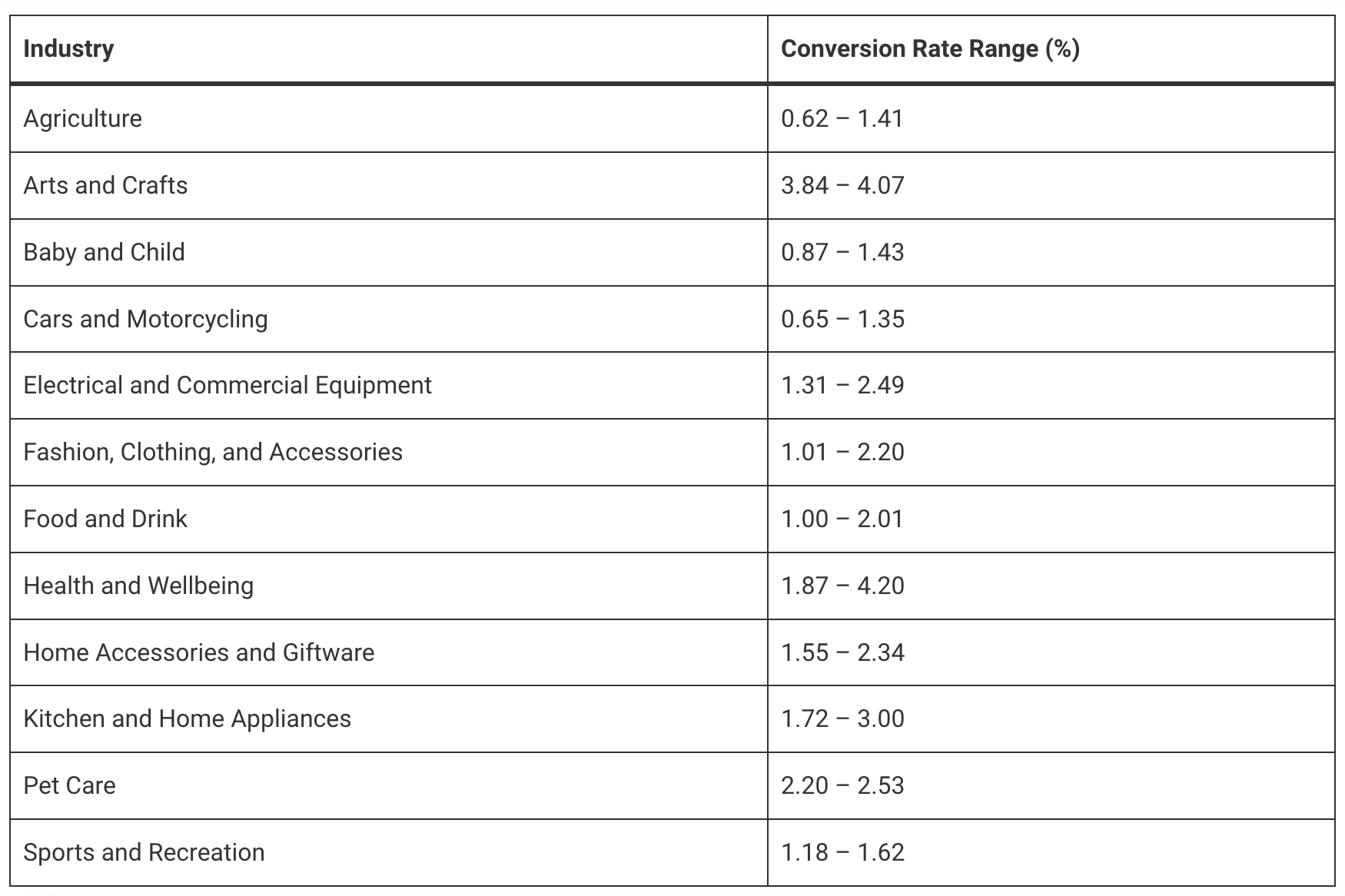
Common CRO mistakes
Ecommerce CRO can help you meet your goals and improve your sales, but it’s important to avoid common mistakes that can diminish your efforts. Avoid these CRO pitfalls:
Testing without a clear hypothesis
When A/B testing, don’t make changes just for the sake of making changes. Have a clear hypothesis about what you’re doing so that you’re clear on the changes you’d like to see. For example, if you’re optimizing your product page, you may add customer testimonials because you hypothesize that doing so will make visitors feel more confident and will increase conversion rates.
Ignoring data
Your decisions should be based on data as often as possible, as this will drive meaningful change. Guessing or relying on your gut can result in costly mistakes. Make sure you’re using tools like Google Analytics to understand the impact of your CRO strategies.
Not using the right trust signals
As mentioned, building credibility and trust goes a long way in improving the performance of your website. Reassure customers by using the right trust icons and signals, such as SSL certificates, customer reviews, secure payment options, and transparent return policies.
Testing multiple page elements simultaneously
Remember the importance of isolating variables in science experiments? The same applies to A/B tests. You don’t want to test too many variations at once, as you’ll have a hard time determining which change led to a positive or negative outcome. Focus on one or two elements at a time to get clear, actionable insights.
Not optimizing for mobile
A large percentage of your potential customers are going to shop from their smartphones. Don’t exclude them. In fact, more than 75% of retail website visits are coming from mobile devices. Mobile optimization is incredibly important and failing to focus on that can cost you conversions.
Create personalized landing pages to support your ecommerce strategy
Personalized landing pages tailored to specific campaigns or customer behaviors can boost ecommerce conversion rates drastically.
Instapage is a leading landing page builder that makes it easy to create and optimize customized landing pages, making it a perfect partner for ecommerce CRO. Customers love using Instapage because of its:
- Intuitive drag-and-drop builder making it easy to create appealing layouts
- Library of 500+ customizable templates
- AI assistance for generating headlines, CTAs, and other content ideas
- A/B testing, with insights on variations that work best and automatic routing to the best-performing pages
- Personalizations that dynamically pair visitor intent to a relevant landing page experience for each ad
- Copy-matching based on visitor-level data like keywords, firmographics, and demographics
Want to test how personalized landing pages can enhance your ecommerce CRO strategy? Start a free 14-day trial of Instapage now.

Try the world's most advanced landing page platform with a risk-free trial.
